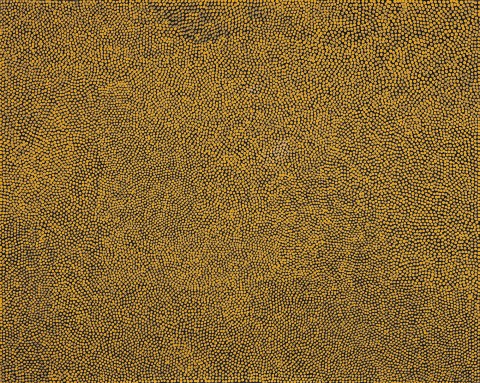TJUNGINPA (MOUSE) DREAMING, 1997
MICK NAMARARI TJAPALTJARRI
synthetic polymer paint on canvas
122.0 x 153.0 cm
bears inscription verso: artist’s name, size and Papunya Tula Artists cat. MN970760
Papunya Tula Artists, Alice Springs
Utopia Art Sydney, Sydney
Sherman Galleries, Sydney (stamped verso)
Gene and Brian Sherman Collection, Sydney
Mick Namarari was the first great practitioner of Western Desert minimalism. Commencing with Wallaby Dreaming, 1982 (Art Gallery of South Australia, Adelaide), Namarari incrementally reduced the emphasis on signs and icons, moving inexorably towards the assembly of subtly shifting fields composed entirely of dots.
When Namarari’s works came to the attention of gallerist, Gabrielle Pizzi in the late 1980s, he was already one of the most accomplished of the founding Papunya painters. Pizzi exhibited several of Namarari’s most abstract works at international art fairs, thereby spearheading the acceptance of Western Desert art in the ultra-competitive world of contemporary art.
Allied with comparable canvases by Turkey Tolson Tjupurrula and Ronnie Tjampitjinpa, Namarari’s works displayed such confidence that his minimal paintings materialised as the inevitable outcome of a process set in train at Papunya in the previous decade. The works of desert minimalists are sometimes thought to have sprung from an essentialist view of nature within an abstracted cosmology, however such explanations do not account for the genre’s earthy origins. It is more accurate to approach Namarari’s works as an interpretation of the specific and the minute in nature, amplified and attenuated to encompass the total visual field.1 Neither should the uncanny similitude of the works of Western Desert minimalists to those produced by European and North American modernists deny the contemporary desert artists their individual voice. It is important therefore, when considering works such as Mick Namarari, Tjunginpa (Mouse) Dreaming, 1997 that the artist’s purpose is weighted.2 The starting point for Namarari’s works can be as subtle as the traces left by an animal nestled in dry grass, Bandicoot Dreaming, 1991 (Museum and Art Gallery Northern Territory, Darwin), or the runways of Tjunginpa, the Spinifex Hopping-mouse, (Notomys alexis), Untitled, 1990 (Art Gallery of New South Wales, Sydney).
Namarari was a custodian of a constellation of sites in the vicinity of the Western Australian/Northern Territory border, several of which were associated with totemic mammals. As a result there has been some confusion regarding the identity of species associated with particular works,3 for example, Tjunginpa is both the name of a hopping-mouse and a totemic site, northwest of Kintore, associated with the species. The behaviour of the mouse sheds some light on the treatment of Namarari’s paintings and the religious significance of this seemingly minor mammal.
Tjunginpa live in cool burrows under the sunbaked desert earth. Tunnels connect their burrows, in much the same way as paths in classical Tingari paintings interconnect sacred sites. In times of abundance, following heavy rain, plagues of Tjunginpa emerge from popholes, dotting the sand between favoured food plants with tiny tracks.4 These trackways are reflected in the treatment of Namarari’s paintings. The emergence of the hopping-mice from their burrows reinforces the Indigenous notion that all life comes from the earth. Moreover, the abundance of Tjunginpa streaming from their popholes substantiates a belief that if the correct ceremonies are conducted, animals and plants will flourish.
Namarari’s luminous late work Tjunginpa, 1997 is a profound meditation on the cryptic, yet distinctive attributes of particular desert species. Such paintings transport us from the gallery and into a world of minute observation and precious knowledge.
1. Kean, J., ‘Mick Namarari Tjapaltjarri’, in Tjukurrtjanu: Origins of Western Desert, National Gallery of Victoria, Melbourne, 2011, pp. 160 – 2
2. Kean, J., ‘Mick Namarari Tjapaltjarri, Shimmer and Shake’, in Brought to Light II, Contemporary Australian Art 1966 – 2006, Queensland Art Gallery Publishing, Brisbane, pp. 78-83
3. Various authors, in Papunya Tula: Genesis and Genius, Art Gallery of New South Wales in association with Papunya Tula Artists, Sydney, 2000, p. 283
4. Moseby, K., Nano, T., and Southgate, R., Tales in the Sand: A Guide to Identifying Australian Arid Zone Fauna Using Spoor and Other Signs, Ecological Horizons, South Australia, 2009, p. 87
JOHN KEAN
